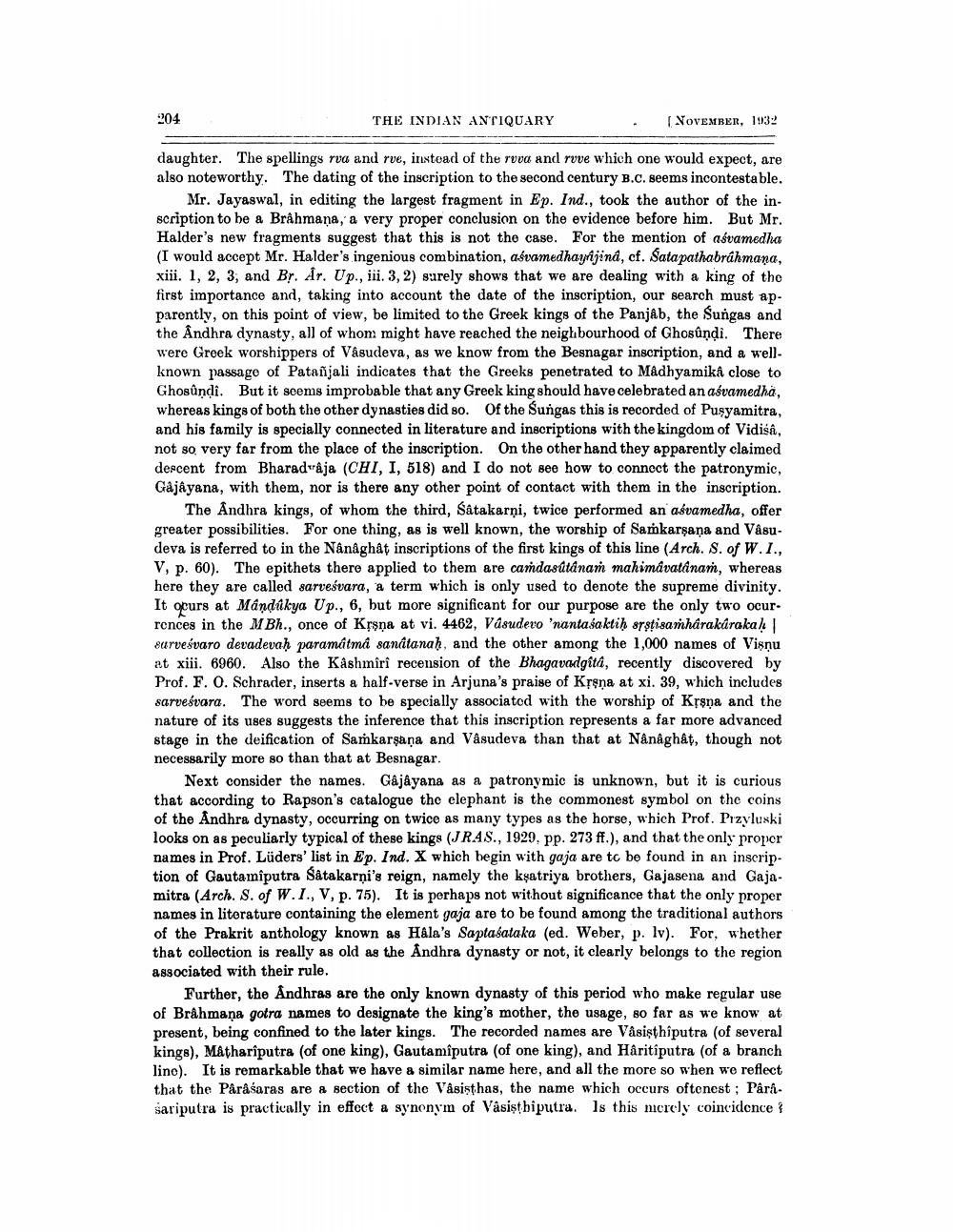________________
204
THE INDIAN ANTIQUARY
(Novemben, 1932
daughter. The spellings rva and rve, instead of the ruva and ruve which one would expect, are also noteworthy. The dating of the inscription to the second century B.C. seems incontestable.
Mr. Jayaswal, in editing the largest fragment in Ep. Ind., took the author of the inscription to be a Brahmana, a very proper conclusion on the evidence before him. But Mr. Halder's new fragments suggest that this is not the case. For the mention of aśvamedha (I would accept Mr. Halder's ingenious combination, aśvamedharjind, cf. Satapathabrahmana, xiii. 1, 2, 3, and Br. Ar. Up., iii. 3, 2) surely shows that we are dealing with a king of the first importance and, taking into account the date of the inscription, our search must ap. parently, on this point of view, be limited to the Greek kings of the Panjab, the Sungas and the Andhra dynasty, all of whom might have reached the neighbourhood of Ghosûndi. There were Greek worshippers of Vasudeva, as we know from the Besnagar inscription, and a wellknown passage of Patañjali indicates that the Greeks penetrated to Madhyamikå close to Ghosûndi. But it seems improbable that any Greek king should have celebrated an aśvamedha, whereas kings of both the other dynasties did so. Of the Sungas this is recorded of Pusyamitra, and his family is specially connected in literature and inscriptions with the kingdom of Vidisa, not so very far from the place of the inscription. On the other hand they apparently claimed dercent from Bharad âja (CHI, I, 518) and I do not see how to connect the patronymic, Gåjåyana, with them, nor is there any other point of contact with them in the inscription.
The Andhra kings, of whom the third, Satakarni, twice performed an asvamedha, offer greater possibilities. For one thing, as is well known, the worship of Samkarsana and Väsudeva is referred to in the Nânåghat inscriptions of the first kings of this line (Arch. S. of W.I., V, p. 60). The epithets there applied to them are caídasdtánam mahimavatánań, whereas here they are called sarveśvara, a term which is only used to denote the supreme divinity. It ocurs at Mandakya Up., 6, but more significant for our purpose are the only two ocur. rences in the M Bh., once of Krşņa at vi. 4462, Vasudero 'nantasaktiḥ srstisarhárakúrakal survešvaro devadevah paramátmå sanatanaḥ, and the other among the 1,000 names of Visņu at xiii. 6960. Also the Kashmiri recension of the Bhagavadgita, recently discovered by Prof. F. O. Schrader, inserts a half-verse in Arjuna's praise of Krena at xi. 39, which includes sarvesvara. The word seems to be specially associated with the worship of Krsna and the nature of its uses suggests the inference that this inscription represents a far more advanced stage in the deification of Samkarşana and Vasudeva than that at Nânåghat, though not necessarily more so than that at Besnagar.
Next consider the names. Gâjâ yana as a patronymic is unknown, but it is curious that according to Rapson's catalogue the elephant is the commonest symbol on the coins of the Andhra dynasty, occurring on twice as many types as the horse, which Prof. Przyluski looks on as peculiarly typical of these kings (JR.4S., 1929, pp. 273 ff.), and that the only proper names in Prof. Lüders' list in Ep. Ind. X which begin with gaja are to be found in an inscription of Gautamiputra Satakarņi's reign, namely the kşatriya brothers, Gajasena and Gajamitra (Arch. S. of W.I., V, p. 75). It is perhaps not without significance that the only proper names in literature containing the element gaja are to be found among the traditional authors of the Prakrit anthology known as Hala's Saptaśataka (ed. Weber, p. lv). For, whether that collection is really as old as the Andhra dynasty or not, it clearly belongs to the region associated with their rule.
Further, the Andhras are the only known dynasty of this period who make regular use of Brâhmana gotra names to designate the king's mother, the usage, so far as we know at present, being confined to the later kings. The recorded names are Vásişthíputra (of several kings), Mathariputra (of one king), Gautamiputra (of one king), and Håritiputra (of a branch lino). It is remarkable that we have a similar name here, and all the more so when we reflect that the Pârâśaras are a section of the Vasisthas, the name which occurs oftenest ; ParaSariputra is practically in effect a synonym of Vasistbiputra. Is this merely coincidence ?




